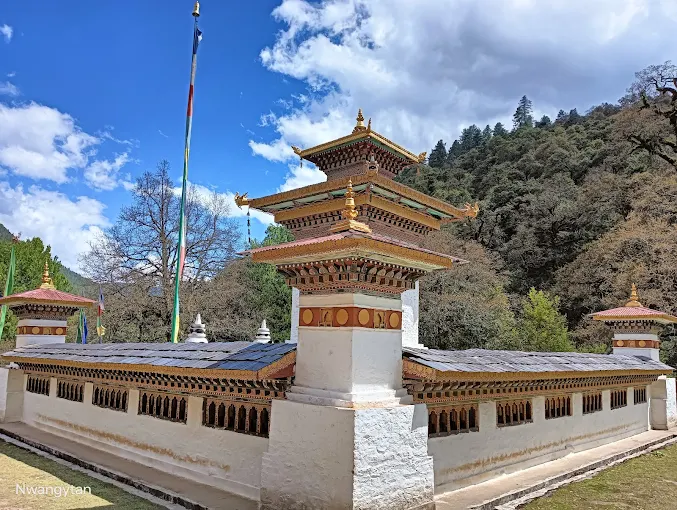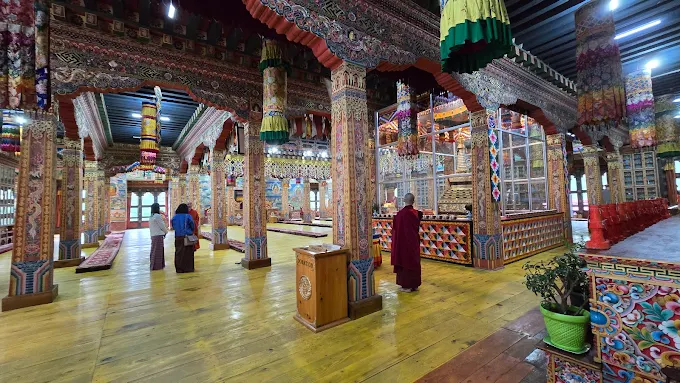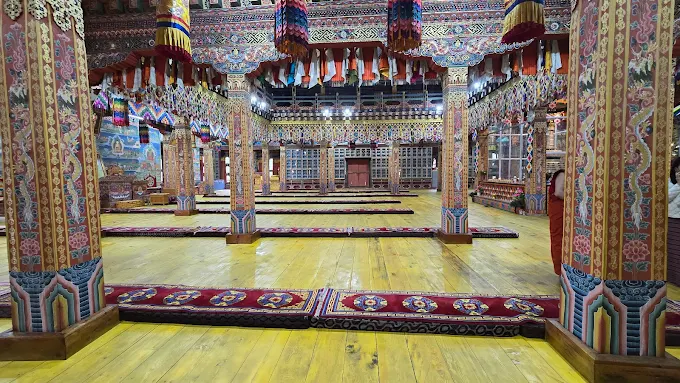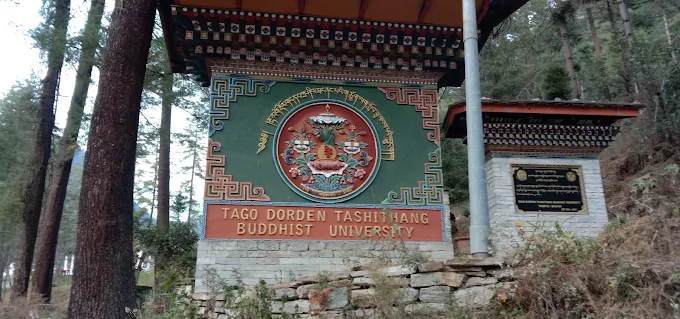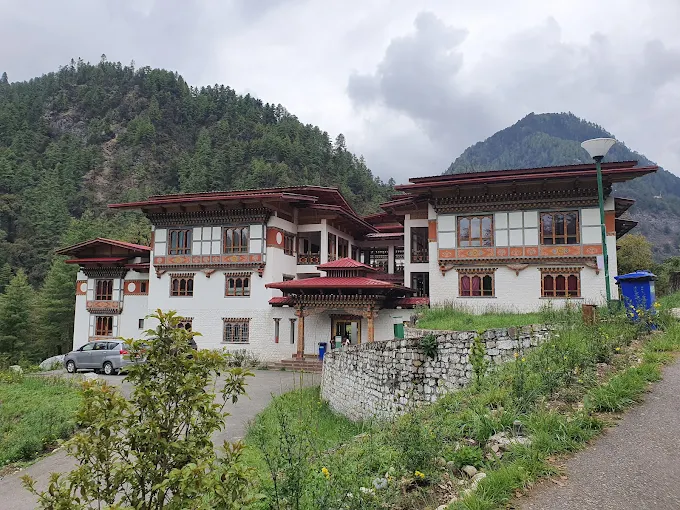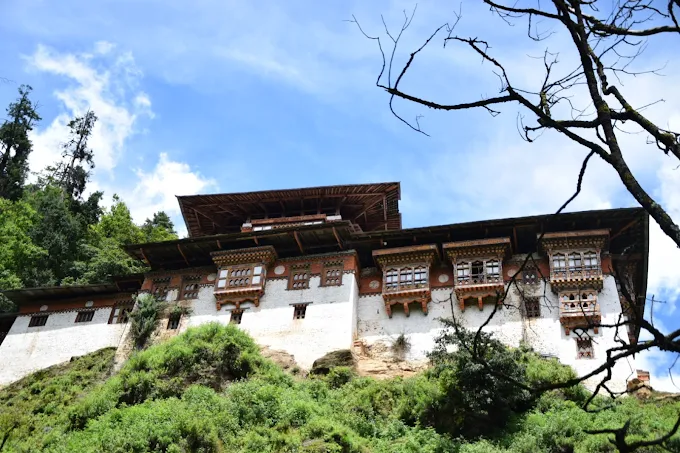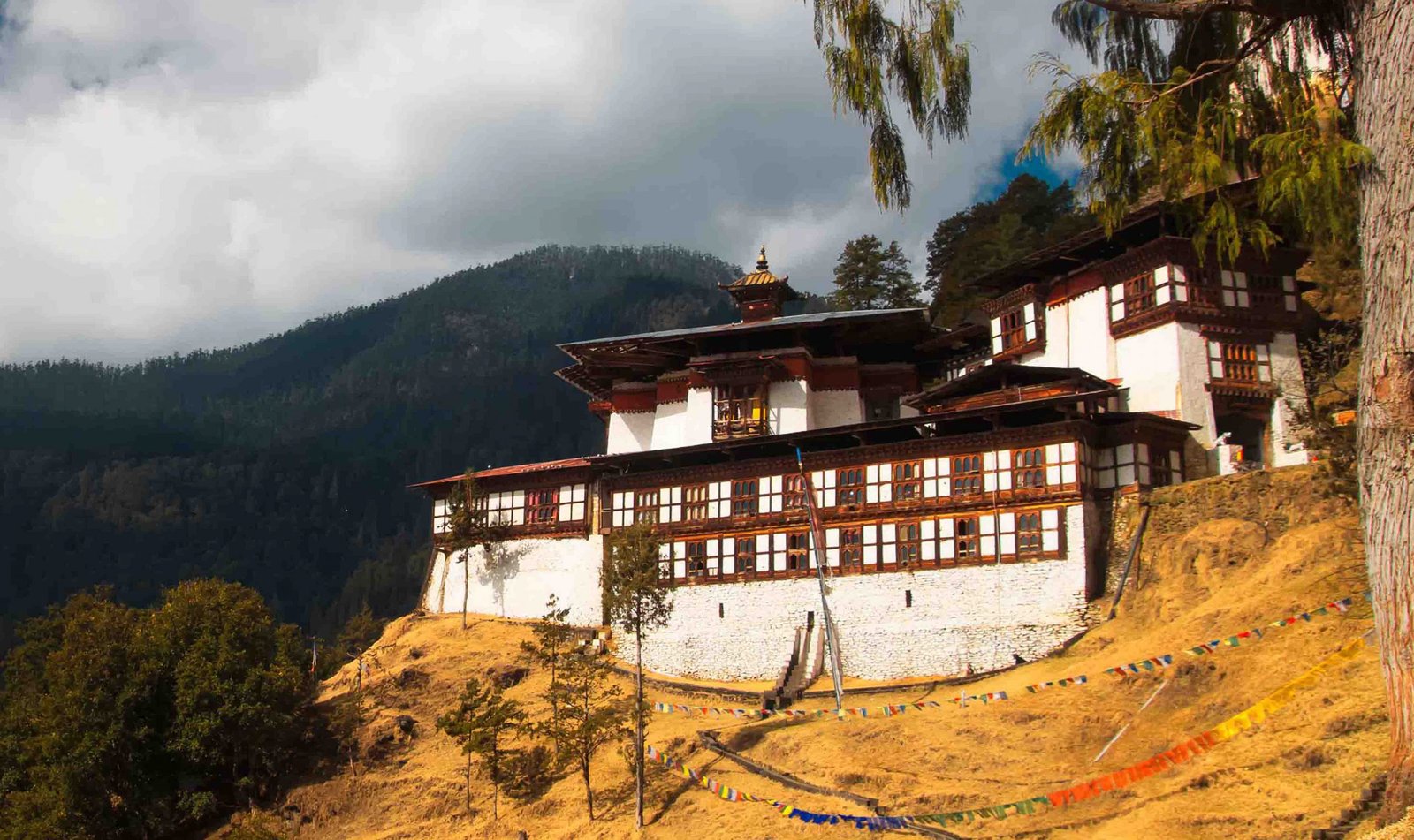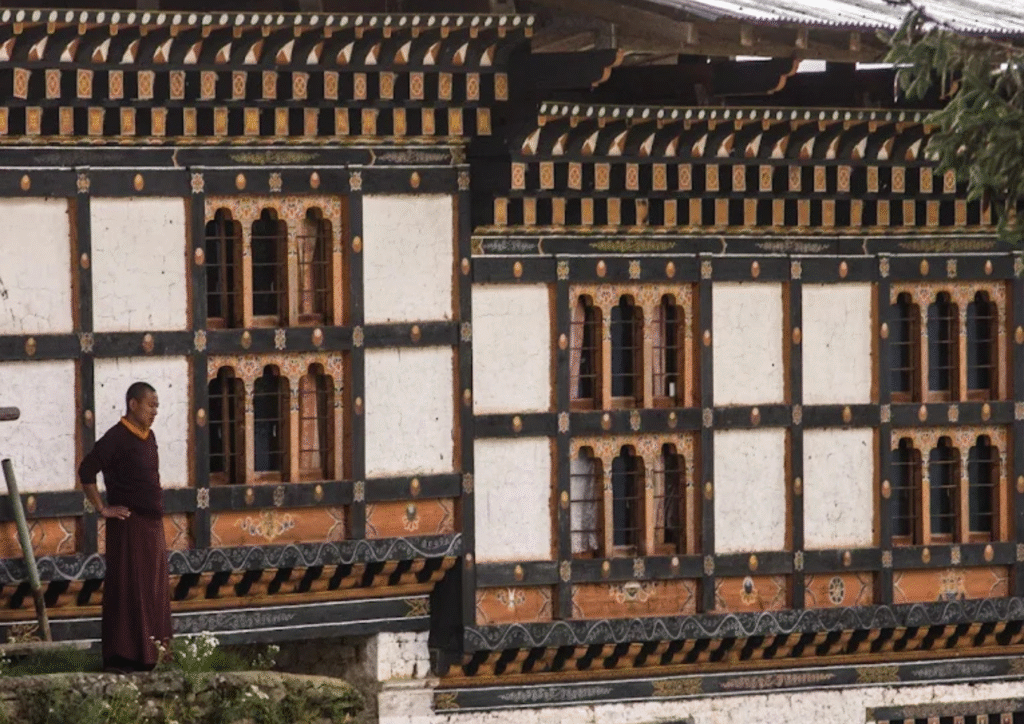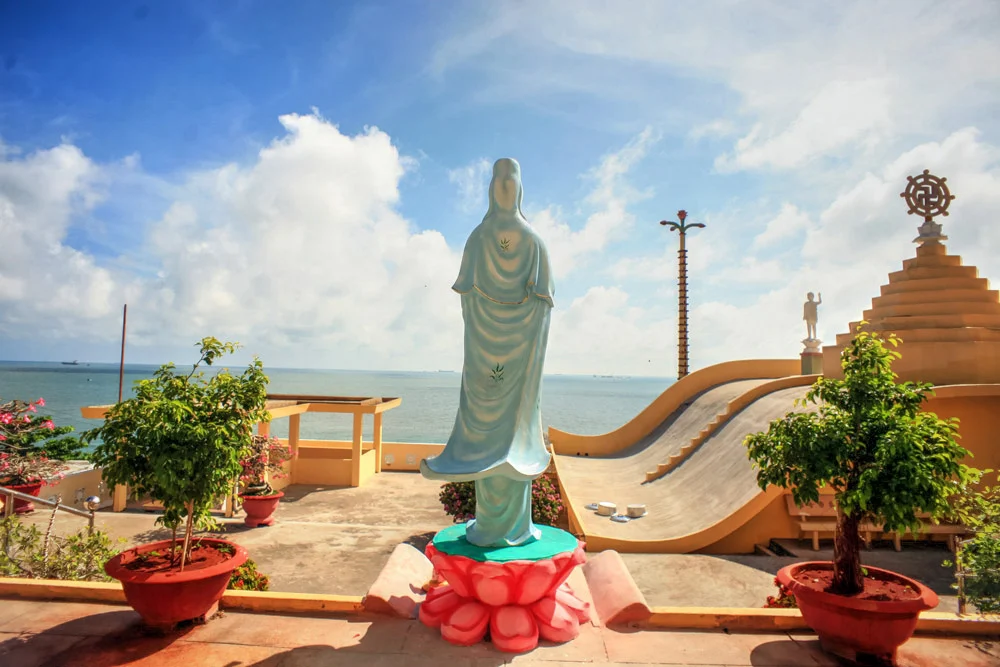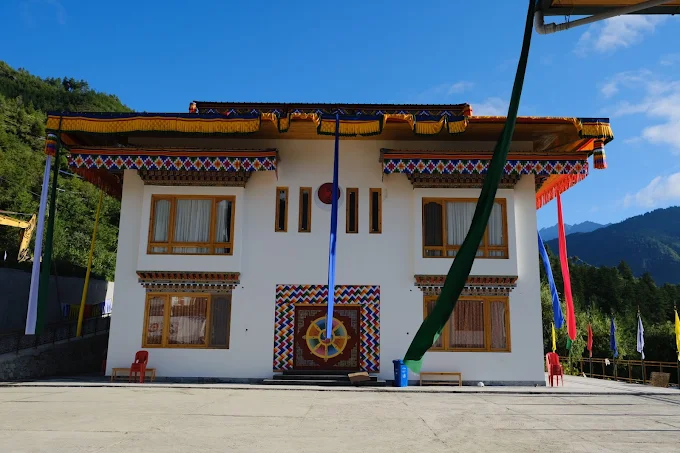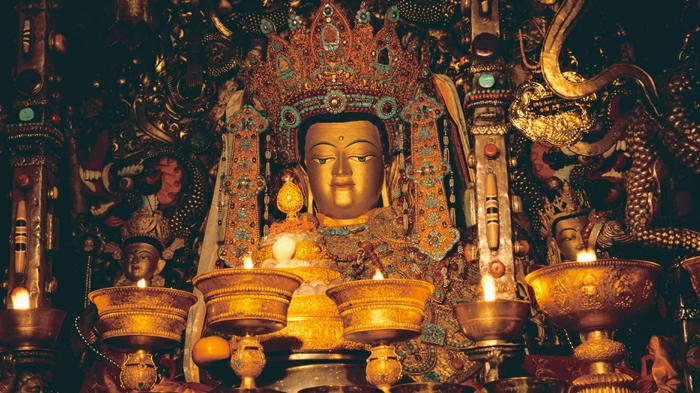Tango Monastery: The Scholarly Sanctuary of Thimphu’s Drukpa Kagyu Legacy
Nestled in the northern reaches of Thimphu’s verdant valley, where the Wangchhu River whispers through ancient pines, Tango Monastery crowns a forested hill at 2,800 meters, its golden roof glinting under dawn’s embrace. In the main temple (lhakhang), monks recite the Om Mani Padme Hum mantra before a bronze statue of Guru Rinpoche, their voices resonating in a sacred cave where he meditated in the 8th century. Founded in the 13th century by Phajo Drugom Zhigpo and rebuilt in 1688 by Gyalse Tenzin Rabgye, this Drukpa Kagyu stronghold serves as Bhutan’s premier Buddhist academic center, the Tango Shedra. Its stone walls and prayer flags flutter in harmony with the Himalayan breeze, inviting contemplation. Each butter lamp lit honors Chenrezig’s compassion, guiding scholars and hermits toward enlightenment. From its perch, Thimphu Dzongkhag unfolds below, tying devotion to Bhutan’s spiritual heart. This sacred haven beckons travelers, seekers, and scholars to ascend its trails and explore the wisdom of Drukpa Kagyu.
Whispers of Wisdom: Overview and Significance
Introduction to Tango Monastery
Tango Monastery, perched on a forested hill in Thimphu Dzongkhag, Bhutan, is a revered Drukpa Kagyu sanctuary, celebrated for its role as a Buddhist academic center and its sacred Guru Rinpoche cave. Accessible via a 45–60-minute hike from the trailhead near Cheri Goemba, it offers a serene retreat where the rustle of pines and distant river murmurs create an aura of peace. Named “Tango” (meaning “horse head” for the hill’s shape), it embodies Bhutan’s spiritual heritage, fostering scholarship and meditation. A cultural and sacred beacon, the monastery weaves history, learning, and Himalayan reverence into a timeless refuge.
Historical Journey
Tango Monastery traces its origins to the 13th century, when Phajo Drugom Zhigpo, a Tibetan lama, established it as a Drukpa Kagyu meditation site, drawn to Guru Rinpoche’s 8th-century cave. In 1619, Zhabdrung Ngawang Namgyal, Bhutan’s unifier, expanded its role as a spiritual center. Rebuilt in 1688 by Gyalse Tenzin Rabgye, the fourth Desi, it became a monastic fortress. By the 20th century, it evolved into the Tango Shedra, a premier institute for Buddhist philosophy, revitalized through renovations in 1990. Its enduring legacy reflects Bhutanese devotion, shaped by monks and scholars across centuries.
Cultural Significance
- Drukpa Kagyu Devotion: Rooted in the Drukpa Kagyu lineage, the monastery centers on Guru Rinpoche and Chenrezig, emphasizing meditation and compassion.
- Bhutanese Heritage: A spiritual cornerstone for the Bhutanese, it preserves rituals like mantra recitation and cham dances, reflecting national identity.
- Academic Hub: The Tango Shedra trains monks in Buddhist philosophy, shaping Bhutan’s spiritual leadership.
- Regional Influence: Pilgrimages and festivals draw devotees from Thimphu and western Bhutan, fostering unity.
Unique Legacy
- Guru Rinpoche Cave: The sacred cave, where Guru meditated, holds profound spiritual potency.
- Tango Shedra: Bhutan’s leading Buddhist academic institute, training over 150 monks annually.
- Hillside Serenity: Its forested perch enhances meditative focus, unique among Thimphu’s monasteries.
- Cultural Symbol: Its resilience mirrors Bhutan’s spiritual fortitude.
Community and Global Impact
- Local Devotion: The monastery hosts retreats and festivals, strengthening Bhutanese Buddhist ties.
- Pilgrimage Hub: Hundreds visit annually, drawn by its cave and scholarly reputation.
- Global Appeal: International scholars and meditators seek its academic and spiritual legacy.
- Cultural Dialogue: Shared rituals unite Bhutanese and global visitors, fostering understanding.
Modern Relevance
- Spiritual Retreat: Tango offers solitude for mindfulness in a connected world.
- Cultural Preservation: It safeguards Drukpa Kagyu practices, ensuring Bhutan’s Buddhist heritage thrives.
- Academic Influence: The Shedra shapes Bhutan’s monastic scholarship.
Historical Anecdotes
- Guru’s Meditation: Guru Rinpoche’s 8th-century retreat sanctified the cave.
- Gyalse’s Rebuild: Tenzin Rabgye’s 1688 reconstruction fortified its role.
- Shedra Founding: The 20th-century academic shift elevated its national stature.
Social Role
- Community Hub: Festivals and teachings unite Thimphu’s Buddhists.
- Educational Center: Monks train in philosophy, nurturing Bhutan’s spiritual future.
- Charitable Spirit: Communal feasts reflect Drukpa Kagyu’s compassion.
Artistic Influence
- Thangka Art: Murals of Guru Rinpoche inspire Bhutanese artists.
- Cultural Icon: The monastery’s silhouette graces local imagery.
- Festival Art: Cham dance masks showcase Bhutanese craftsmanship.
Tango Monastery’s forested hill, crowned by its golden-roofed lhakhang, weaves a narrative of devotion and scholarship that echoes through Bhutan’s history. From Phajo Drugom Zhigpo’s founding to its modern role as the Tango Shedra, the monastery’s legacy pulses with Drukpa Kagyu wisdom, uniting monks and pilgrims in pursuit of enlightenment. Its sacred cave and serene trails set the stage for an architectural tapestry that mirrors its Himalayan soul. As we delve into its physical and spiritual features, Tango’s design reveals how its austere beauty nurtures profound learning and contemplation.
Crafted by the Valley: Architectural and Spiritual Features
Iconic Design
Tango Monastery’s architecture blends Bhutanese Drukpa Kagyu austerity with its forested hillside setting, creating a sanctuary that harmonizes with Thimphu’s rugged landscape. Stone walls and wooden roofs, adorned with prayer flags, rise from the 2,800-meter slope, reflecting Buddhist humility. The compact layout, centered on the main lhakhang, prioritizes academic and meditative function, with courtyards fostering community. Its perch above the Wangchhu River, overlooking Thimphu Dzongkhag, amplifies spiritual resonance, tying the monastery to Bhutan’s Himalayan ethos.
Key Structures
- Main Lhakhang: The spiritual and academic core, housing Guru Rinpoche’s statue, rebuilt in 1688.
- Guru Rinpoche Cave: A sacred meditation cave, sanctified in the 8th century.
- Shedra Halls: Modern study rooms for 150+ monks, added in 1990.
- Chorten Courtyard: Stone stupas honor past lamas, surrounded by prayer wheels.
- Monastic Quarters: Timber dormitories for monks, restored in 1990.
- Prayer Flag Poles: Tall poles strung with flags, dotting the hillside.
- Library Pavilion: A small archive of Buddhist texts, supporting Shedra studies.
Worshipped Statues
- Guru Rinpoche (Padmasambhava): A bronze statue in the main lhakhang, depicting meditation, embodies spiritual guidance.
- Chenrezig (Avalokitesvara): A white stone statue, symbolizing compassion, radiates serenity.
- Vajrapani: A dark bronze statue, representing protection, flanks the altar.
- Spiritual Role: Monks offer butter lamps to Guru Rinpoche and Chenrezig, seeking wisdom and compassion.
Materials and Techniques
- Construction: Local stone and timber, joined with Bhutanese techniques, withstand Himalayan weather.
- Artistry: Thangka murals and wooden carvings, crafted by Thimphu artisans, reflect Drukpa Kagyu symbolism.
- Cultural Essence: The design prioritizes academic and meditative simplicity, distinct from dzong grandeur.
Signature Elements
- Guru Rinpoche Cave: The cave’s sanctity anchors the monastery’s spiritual mission.
- Shedra Complex: Modern halls symbolize its academic role.
- Prayer Flags: Fluttering flags carry prayers across the valley.
Lesser-Known Features
- Ancient Thangkas: Faded murals in the lhakhang depict Chenrezig’s forms.
- Hidden Relic: A Guru Rinpoche footprint in the cave, revered by monks.
- Old Prayer Wheel: A weathered mani wheel, spun since the 17th century.
Preservation Efforts
- Restoration (1990): Community efforts rebuilt Shedra halls and dormitories.
- Challenges: Monsoon rains erode stonework, requiring ongoing care.
- Modern Additions: Solar panels provide minimal lighting for study.
Environmental Integration
- Forest Harmony: The monastery’s design respects Thimphu’s pine ecosystem.
- Eco-Practices: Monks maintain trails and protect the Wangchhu watershed.
- Wildlife Haven: Deer and birds thrive nearby, enhancing serenity.
Artisan Narratives
- Mural Restorers: Thimphu artists revived thangkas, preserving sacred art.
- Carpenters: Local craftsmen rebuilt wooden roofs, blending tradition and durability.
- Textile Weavers: Nuns crafted prayer flags, embedding blessings.
Symbolic Details
- Prayer Flags: Five colors balance elements, spreading dharma.
- Chortens: Represent the Buddha’s mind, guiding pilgrims.
- Thangkas: Depict enlightenment’s path, inspiring study.
Landscape Integration
- Hillside Perch: Enhances meditative and academic focus.
- Wangchhu Views: The river’s flow mirrors inner calm.
- Pine Forests: Provide solitude and spiritual resonance.
Tango’s stone lhakhangs and sacred cave, nestled in Thimphu’s forested hills, are more than architectural marvels; they are sanctuaries for the Drukpa Kagyu practices that define its scholarly soul. The statues of Guru Rinpoche and Chenrezig, glowing with butter lamps, anchor rituals that connect monks to Bhutan’s spiritual lineage. These sacred spaces, alive with chants and study, invite visitors to engage with the monastery’s living traditions. As we explore its rituals, Tango’s role as an academic and meditative retreat comes to life, guiding devotees toward wisdom and compassion.
Rites of the Mind: Rituals and Practices
Daily Sacred Rites
- Morning Chanting: Monks recite the Om Mani Padme Hum mantra at dawn, cultivating compassion.
- Meditation Sessions: Silent meditation, held thrice daily, focuses on Mahamudra practices.
- Butter Lamp Offerings: Devotees light lamps before Guru Rinpoche, praying for wisdom.
Unique Practices
- Ngondro Practice: Monks undertake preliminary practices in the cave, preparing for tantric meditation.
- Shedra Debates: Monastic debates in study halls hone philosophical insight, a Drukpa Kagyu hallmark.
- Signature Ritual: Circumambulating the Guru Rinpoche cave, tied to the monastery’s sacred history.
Festival Traditions
- Tango Tshechu (10th day, 9th lunar month): Cham dances and Guru Rinpoche offerings draw pilgrims.
- Lhabab Duchen: Ceremonies honor the Buddha’s descent, with chorten circuits.
- Drukpa Tshechu: Monks perform sacred dances, blessing visitors.
- Statue Veneration: Guru Rinpoche’s statue is adorned with silk during festivals.
Visitor Engagement
- Accessible Rituals: Visitors can join chants or circumambulate the cave, guided by monks.
- Offerings: Butter lamps and prayer flags, available at the monastery, invite participation.
- Drukpa Etiquette: Bow before statues and maintain silence during study.
Spiritual Community Roles
- Monastics: Over 150 monks lead rituals and study at the Shedra.
- Lamas: Senior teachers guide advanced tantric practices.
- Lay Devotees: Thimphu villagers offer supplies and maintain trails.
Interfaith Connections
- Syncretic Practices: Some blend Buddhist rites with Bon offerings, honoring local spirits.
- Outreach: Festivals welcome diverse faiths, fostering unity.
- Education: Monks share Drukpa Kagyu philosophy with visitors.
Ritual Symbolism
- Butter Lamps: Dispel ignorance with wisdom’s light.
- Circumambulation: Represents devotion’s endless path.
- Cham Dances: Enact spiritual triumph over obstacles.
Seasonal Variations
- Summer Rites: Vibrant with wildflowers, ideal for Tango Tshechu.
- Winter Study: Cold enhances Shedra focus.
- Monsoon Chants: Rain amplifies mantra resonance.
Monastic Life
- Daily Routine: Monks rise at 4:00 AM for chants, study, and debates.
- Community Service: Monks guide pilgrims and maintain lhakhangs.
- Shedra Training: Monks study sutras, tantras, and philosophy for 9 years.
Tango’s rituals, from mantra recitations to scholarly debates, breathe life into its forested sanctuary, connecting devotees to the Drukpa Kagyu lineage. The Guru Rinpoche cave and Shedra halls, vibrant with practice and learning, invite visitors to engage with Bhutan’s spiritual heart, whether through meditation or observation. For travelers, these rites offer a glimpse into Thimphu’s sacred traditions, accessible via the gentle trails. As we turn to visitor information, Tango’s hillside setting guides practical planning, ensuring a meaningful ascent to this scholarly haven.
Journey to Insight: Visitor Information
Navigating to Tango Monastery
- Location: Northern Thimphu Dzongkhag, 2,800 meters, 45–60-minute hike from the trailhead near Cheri Goemba, 14 km from Thimphu center.
- Landmarks: Near Dodena village and Wangchhu River, with trailhead signs in Dzongkha and English.
- Routes: Drive to Dodena, then hike the Tango-Cheri Trail, a shaded path.
Address of Tango Monastery
- Dzongkha: Tango Goenpa, Thimphu Dzongkhag, Bhutan.
- English: Tango Monastery, Thimphu District, Bhutan.
Visiting Hours and Etiquette
- Hours: Open daily, 6:00 AM–5:00 PM, with monks available for guidance.
- Etiquette: Dress modestly, remove shoes before lhakhangs, and avoid disturbing study sessions.
- Drukpa Custom: Offer butter lamps with both hands and bow to statues.
Transport Options
- By Foot: Hike from Dodena (45–60 minutes, easy to moderate difficulty).
- By Taxi: Drive to Dodena trailhead, then trek upward.
- By Horse: Local guides offer pack animals, arranged at Dodena.
Accessibility and Safety
- Mobility: Moderate trails may challenge those with mobility issues; no ramps available.
- Safety: Stable paths with guideposts; carry layers for cool weather.
- Tips: Wear sturdy hiking shoes and bring water for the ascent.
Amenities and Surroundings
- Facilities: Basic dormitories for pilgrims; no restrooms or shops on-site.
- Nearby: Cheri Goemba and Tashichho Dzong, within 15 km of trailhead, offer cultural experiences.
- Dining: Vegetarian meals at Thimphu’s eateries, like Bhutan Kitchen, before trekking.
Immersive Visitor Tips
- Best Timing: Early morning hikes offer clear views and monk chants.
- Sensory Moments: Inhale pine-scented air and hear mantra recitations.
- Statue Connection: Offer butter lamps to Guru Rinpoche and reflect briefly.
- Festival Planning: Attend Tango Tshechu for cham dances.
Nearby Cultural Experiences
- Cheri Goemba: A sister monastery, 1 km from trailhead, with Zhabdrung’s relics.
- Tashichho Dzong: Thimphu’s iconic fortress, 15 km away.
- National Memorial Chorten: A sacred stupa, 12 km from trailhead.
Photography Tips
- Best Angles: Capture the main lhakhang at sunrise for golden light.
- Respectful Shots: Avoid photographing monks during study without permission.
- Scenic Views: The Wangchhu Valley offers stunning shots.
- Equipment: A lightweight camera suits the trek.
The ascent to Tango Monastery, guided by Thimphu’s forested trails, is a journey that blends physical effort with intellectual and spiritual discovery, inviting visitors to engage with its Drukpa Kagyu traditions. The monastery’s lhakhangs and cave, vibrant with chants and study, offer a window into Bhutan’s sacred heart, where wisdom feels tangible. Beyond its physical serenity, Tango’s deeper cultural and spiritual significance enriches the experience, revealing the essence of Himalayan Buddhism. As we explore these insights, the monastery’s role as a beacon of scholarship and compassion comes into sharper focus, deepening our connection to its sacred legacy.
Cultural and Spiritual Insights
Drukpa Kagyu Philosophy
Tango Monastery embodies Drukpa Kagyu’s core: compassion and wisdom through meditation and study. Guru Rinpoche and Chenrezig inspire devotees to transcend ego, reflected in chants and debates. Mahamudra teachings emphasize direct realization of mind’s nature, guiding monks toward enlightenment.
Environmental Spirituality
The monastery’s hillside perch ties it to Himalayan reverence for nature. The Wangchhu’s flow and pine forests foster meditative calm, with offerings honoring local deities. The landscape invites reflection on harmony with the natural world.
Artistic Symbolism
Thangka murals depict Guru Rinpoche’s triumphs, symbolizing spiritual victory. Prayer flags balance elements, while chortens represent the Buddha’s mind. These elements weave Drukpa Kagyu ideals into the monastery’s aesthetic.
Community Resilience
Founded by Phajo’s devotees, Tango reflects Bhutanese perseverance through harsh winters. Its Shedra role showcases collective faith, sustained by volunteer-led efforts, uniting Thimphu’s Buddhists.
Environmental Stewardship
The monastery’s pristine slopes foster Buddhist environmental ethics. Monks protect trails and the Wangchhu watershed, ensuring balance. Visitors are urged to honor the Himalayas’ sanctity.
Meditative Practices
Drukpa Kagyu meditation, including Mahamudra and Ngondro, cultivates awareness. The Guru Rinpoche cave offers spaces for retreats, guided by lamas, amplifying inner peace amidst Thimphu’s hills.
Cultural Narratives
- Guru’s Legacy: Tales of his 8th-century meditation fuel devotion.
- Shedra Stories: Monks share debate experiences, linking past and present.
- Festival Lore: Tango Tshechu dances carry ancient traditions.
Historical Context
- Drukpa Kagyu Spread: Phajo’s work shaped Bhutan’s Buddhist identity.
- Zhabdrung’s Era: 17th-century patronage strengthened Tango’s role.
- Shedra Impact: Its academic legacy influences Bhutan’s monastic tradition.
Reflecting on the Journey
Tango Monastery, cradled in Thimphu’s forested hills, is a sanctuary where scholarship meets compassion. Its lhakhangs and Guru Rinpoche cave, alive with Drukpa Kagyu wisdom, embody Bhutan’s spiritual soul, inviting all to seek enlightenment. The monastery’s trails, worn by centuries of pilgrims and scholars, tell a story of resilience and devotion, rooted in Himalayan faith. Whether meditating before Chenrezig, observing Shedra debates, or tracing Bhutan’s Buddhist heritage, visitors find a space to reflect and connect. As you descend, the Wangchhu’s murmur and prayer flags’ flutter linger, a reminder that wisdom is always within reach.
